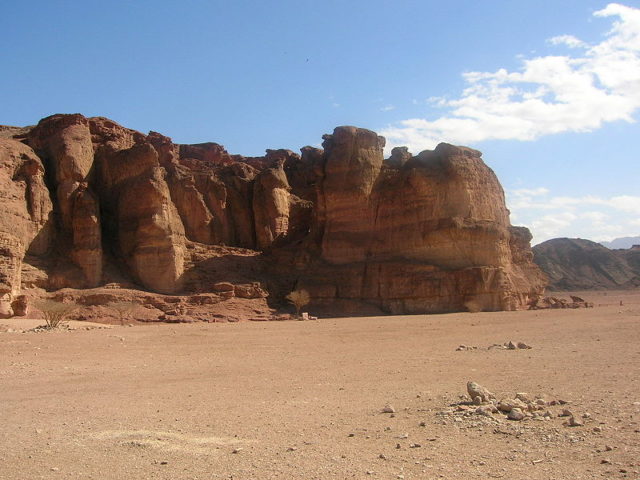Israel’s Timna Valley, although not mentioned in the Bible, was the scene of extensive copper mining during Biblical times. There are many individuals who believe that King Solomon’s celebrated mines are located among the copper manufacturing camps found within the barren valley. The desolate environmental conditions at Timna have resulted in the incredible preservation of 3,000-year-old organic materials and buildings.
This immaculate preservation has offered an exclusive introspection into the culture and practices of an ancient, yet highly complex and advanced society, to a group of archaeologists from Israel’s Tel Aviv University. In recent times, a highly innovative military protection system, including donkey stables and a well-defined gatehouse complex, have been uncovered at Timna. These structures allude to the fact that the society depended considerably on long distance trading schemes, and had a highly organized military system. It was built in Biblical times, during the reign of Kings David and Solomon in the 10th century BC.

Dr. Erez Ben-Yosef of Tel Aviv University’s Institute of Archaeology, one of the leaders of the Timna research, and his excavation team, along with his colleagues Dr. Dafna Langgut and Dr. Lidar Sapir-Hen, explain that there are no strong accounts or descriptions of King Solomon’s mines in the Old Testament. There are, however, numerous references to disagreements and military encounters between the Edomites and Israel in the Arava Valley. According to Bible accounts, David would travel many miles outside of Jerusalem and participate in military conflicts that would take place in in the desert; striking down “18,000 Edomites in the Valley of Salt” (2 Samuel 8:13). Now that the evidence of defensive measures such as the sophisticated fortification has been uncovered, the team now believes that copper was the reason why David traveled to and waged war in this remote region, hundreds of miles away.

In ancient times, copper was a very rare substance and extremely challenging to produce, Dr. Ben-Yosef explains. Due to its rarity, copper was probably a highly sought-after commodity, and therefore initiated many military conflicts. The discovery of the military stronghold and gatehouse complex allows a view into a period of military pressures and major volatility within the region and its surroundings at that time.
The two-room fortress, situated in one of the main smelting camps in the Timna Valley, is amazingly intact and includes pens for draft animals and other livestock. Evidence of a complex long-distance trade system was also unearthed. Trade routes possibly included the Mediterranean coastal plain, the northern Edomite plateau, and Judea. Founded on exact analysis of seeds, pollen, and fauna, the research team believes that the livestock was fed with high-quality hay and grape pomace. Such quality, nutritious food was not obtainable in the area and was probably delivered from the Mediterranean region. The University team also located piles of dung and masses of animal bones in the stock pens that were so well preserved that the team was able to precisely investigate the food the animals were fed with. The provision of high-quality food signifies that special treatment and care was given to the livestock. This conclusion would appropriately fit in with the key function that donkeys played in the manufacture of copper and trading, particularly in an area that was logistically a major challenge.
was also unearthed. Trade routes possibly included the Mediterranean coastal plain, the northern Edomite plateau, and Judea. Founded on exact analysis of seeds, pollen, and fauna, the research team believes that the livestock was fed with high-quality hay and grape pomace. Such quality, nutritious food was not obtainable in the area and was probably delivered from the Mediterranean region. The University team also located piles of dung and masses of animal bones in the stock pens that were so well preserved that the team was able to precisely investigate the food the animals were fed with. The provision of high-quality food signifies that special treatment and care was given to the livestock. This conclusion would appropriately fit in with the key function that donkeys played in the manufacture of copper and trading, particularly in an area that was logistically a major challenge.

The gatehouse structure was also possibly an important landmark. Dr. Ben-Yosef believes that the gatehouse would have had a symbolic or symbolic function in addition to its administrative and defensive roles. The gatehouse was assembled of hard-wearing stone to protect its inhabitants from any possible outside attacks, Science News Journal reported.
The site was discovered, in 1934, by American archaeologist Nelson Glueck, who called the copper smelting site “Slaves’ Hill”. The name “Slaves’ Hill” was used since Glueck believed that the site had all the markings of an Iron Age slave camp. Such indicators include fiery furnaces and a challenging stone barrier designed to prevent the escape of slaves. In 2014, this theory was discredited by Dr. Ben-Yosef and his colleagues. The group revealed that the perfectly preserved apparel and apparent diets of the miners indicated a complex, hierarchical civilization as opposed to a society powered by slaves and masters.

Dr. Ben-Yosef states that although the historical accuracy of the Old Testament accounts could be questioned, they can no longer be contradicted through the use of archaeology and its findings. These discoveries agree with the Biblical accounts of battles fought with a civilized, structured society south of the Dead Sea.
Ben-Yosef and his team will continue to research and explore this area to re-create the features of this remote society and the way its people worked the copper mines. There is a significant potential for even more substantial discoveries in the future, as 21st-century research methods such as ancient residue and DNA analysis are combined with the unique preservation of organic materials in Timna.
